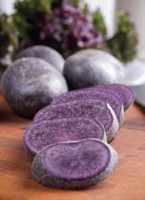This Spud’s for You
The underappreciated potato finally gets its due
In a crawfish boil it is essential. A burger without it is blasphemous. If not included, a  backyard barbecue or picnic seems incomplete. Ahh, the potato. Simple yet versatile, this rock-solid starch is rarely the star of the culinary show, but it certainly plays an important role as a supporting cast member. No matter which form or fashion you favor, be it creamy potato salad, crispy French fries, cheesy au gratin, flaky hash browns, rich soup, loaded potato skins, classic buttery mashed, smothered, scattered, covered or chunked, the super spud is America’s most beloved and popular vegetable.
backyard barbecue or picnic seems incomplete. Ahh, the potato. Simple yet versatile, this rock-solid starch is rarely the star of the culinary show, but it certainly plays an important role as a supporting cast member. No matter which form or fashion you favor, be it creamy potato salad, crispy French fries, cheesy au gratin, flaky hash browns, rich soup, loaded potato skins, classic buttery mashed, smothered, scattered, covered or chunked, the super spud is America’s most beloved and popular vegetable.
Over the years, weight-conscious mortals have tried to villanize the potato, but a terrible tuber it is not! In fact, the potato contains many essential nutrients. It is naturally low in fat, has nearly half the daily value of vitamin C, is one of the best sources of fiber and potassium you can eat and has only about 110 calories per serving. In truth, the potato on its own is not the fat culprit we’ve made it out to be. Rather the guilty party is man and what we’ve chosen to do with the poor, innocent spud. Let’s face it, even broccoli spears and carrot sticks when battered, deep-fried or slathered in cheese or butter are hardly waistline slimming. So ask not what the spud has done to you, but what you have done to the spud.
Potatoes can be prepared just about any way imaginable, from baking and grilling to frying and sautéing. They are used in soups, soufflés, salads, stuffings and stews and are served at breakfast, lunch and dinner. In addition to their versatility in the kitchen, these culinary chameleons also have several practical uses. Potatoes have been known to relieve a skin burn or tired eyes; act as polish on shoes or silverware; remove glue from hands; extract excess salt from dishes; prevent eyeglasses from fogging; and lure worms from houseplants to eliminate the destructive pests.
Today, more types of potatoes are appearing in grocery stores, which makes selecting the right one for a particular use somewhat confusing. Although there are more than 5,000 potato varieties found worldwide, most of which are hybrids, they can generally be categorized into six groups based on their skin color: yellow, red, russet, white, blue and purple.
Russet Potatoes: The most widely used potato variety in the United States, russets are primarily grown in the Northwest and available year-round. These brown-skinned potatoes are high in starch and have white flesh, but when cooked they’re creamy and fluffy, making them ideal for mashing, baking, frying and roasting.
Red Potatoes: These rosy, thin-skinned potatoes can have either white or yellow flesh and a dense, moist, waxy texture. Due to their smaller size, they are often called “new potatoes,” however, the term applies to any potato harvested before it reaches maturity. Red potatoes are available most of the year and are great for salads, boiling, roasting, grilling and steaming. However, due to their higher sugar content, they do not keep as long other types.
Yellow Potatoes: Dense and creamy with a buttery flavor, these are available almost all year and are increasing in popularity. Oblong in shape with thin skin and golden flesh on the inside, they are ideally suited for baking, steaming, roasting and au gratin dishes.
White Potatoes: These are available in round or oblong shapes, both of which have a  light tan skin and a medium starch level. This all-purpose potato has a creamy texture and is well suited for nearly any cooking preparation. The round variety is available all year long, while the oval variety is only seen between spring and summer.
light tan skin and a medium starch level. This all-purpose potato has a creamy texture and is well suited for nearly any cooking preparation. The round variety is available all year long, while the oval variety is only seen between spring and summer.
Blue and Purple Potatoes: These delicately flavored heirloom potatoes are primarily available in the fall, and while they are far less common in the U.S. than other types, they are gaining in popularity. The insides range in color from white or pale lavender to indigo blue. They are best when steamed, baked or tossed in a salad, however, microwaving them best retains their unique color.
